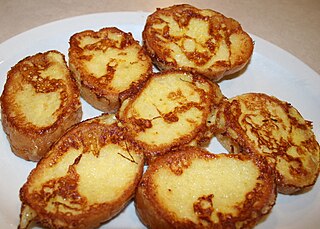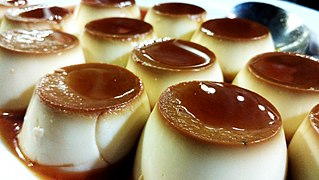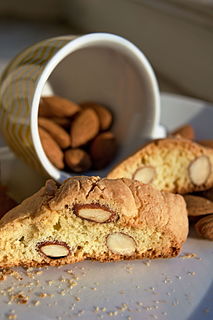
Dessert is a course that concludes a meal. The course consists of sweet foods, such as confections, and possibly a beverage such as dessert wine and liqueur. In some parts of the world, such as much of Greece and West Africa, and most parts of China, there is no tradition of a dessert course to conclude a meal.

Champagne is a sparkling wine originated and produced in the Champagne wine region of France under the rules of the appellation, that demand specific vineyard practices, sourcing of grapes exclusively from designated places within it, specific grape-pressing methods and secondary fermentation of the wine in the bottle to cause carbonation.

French toast is a dish of sliced bread soaked in beaten eggs and often milk or cream, then pan fried. Alternative names and variants include "eggy bread", "Bombay toast", "gypsy toast", and "poor knights".

Girl Scout Cookies are cookies sold by Girl Scouts in the United States to raise funds to support Girl Scout councils and individual troops. The cookies are widely popular and are commonly sold by going door-to-door, online, through school or town fundraisers, or at "cookie booths" commonly set up at storefronts. The program is intended to both raise money and improve the financial literacy of girls. During an average selling season, more than one million girls sell over 200 million packages of cookies and raise over $800 million. The first known sale of cookies by Girl Scouts was in 1917. Cookie sales are organized by 112 regional Girl Scout councils who select one of two national bakeries to buy cookies from.

Crème caramel, flan, caramel pudding or caramel custard is a custard dessert with a layer of clear caramel sauce.

Cream soda is a sweet soft drink. Generally flavored with vanilla and based on the taste of an Ice cream float, a wide range of variations can be found worldwide.

Cheesecake is a sweet dessert consisting of one or more layers. The main, and thickest, layer consists of a mixture of a soft, fresh cheese, eggs, and sugar. If there is a bottom layer, it most often consists of a crust or base made from crushed cookies, graham crackers, pastry, or sometimes sponge cake. Cheesecake may be baked or unbaked.

A macaroon is a small cake or biscuit, typically made from ground almonds, coconut or other nuts, with sugar and sometimes flavourings, food colouring, glacé cherries, jam or a chocolate coating; or a combination of these or other ingredients. Some recipes use sweetened condensed milk. Macaroons are sometimes baked on edible rice paper placed on a baking tray.

Biscotti, known also as cantucci, are Italian almond biscuits that originated in the Tuscan city of Prato. They are twice-baked, oblong-shaped, dry, crunchy, and may be dipped in a drink, traditionally Vin Santo.

A Kyiv cake is a brand of dessert cake, made in Kyiv, Ukraine since December 6, 1956 by the Karl Marx Confectionery Factory. It soon became popular all over the Soviet Union.

Vanilla is frequently used to flavor ice cream, especially in North America, Asia, and Europe. Vanilla ice cream, like other flavors of ice cream, was originally created by cooling a mixture made of cream, sugar, and vanilla above a container of ice and salt. The type of vanilla used to flavor ice cream varies by location. In North America and Europe consumers are interested in a more prominent, smoky flavor, while in Ireland, a more anise-like flavor is desired. To create the smooth consistency of ice cream, the mixture has to be stirred occasionally and then returned to the container of ice and salt to continue the solidification process. According to Iced: 180 Very Cool Concoctions, many people often consider vanilla to be the "default" or "plain" flavor of ice cream.
Biscuits Fossier is a Reims, France based manufacturer of biscuits, gingerbread, sweets and marzipan-based confectionery.

Sponge cake is a light cake made with egg whites, flour and sugar, sometimes leavened with baking powder. Sponge cakes, leavened with beaten eggs, originated during the Renaissance, possibly in Spain. The sponge cake is thought to be one of the first of the non-yeasted cakes, and the earliest attested sponge cake recipe in English is found in a book by the English poet Gervase Markham, The English Huswife, Containing the Inward and Outward Virtues Which Ought to Be in a Complete Woman (1615). Still, the cake was much more like a cracker: thin and crispy. Sponge cakes became the cake recognized today when bakers started using beaten eggs as a rising agent in the mid-18th century. The Victorian creation of baking powder by English food manufacturer Alfred Bird in 1843 allowed the addition of butter to the traditional sponge recipe, resulting in the creation of the Victoria sponge. And today our celebrations are incomplete without cakes. Cakes are available in millions of flavours and have many recipes as well. Sponge cakes have become snack cakes via the Twinkie.

Qurabiya is a shortbread-type biscuit, usually made with ground almonds. Versions are found in most Arab and Ottoman cuisines, with various different forms and recipes. They are similar to polvorones from Andalusia.

An ijzerkoekje is a soft cookie, traditionally eaten by Dutch fishermen, especially in Vlaardingen, one of the main harbours of the Netherlands during the 19th and 20th centuries. It is an oval cookie around 0.6-0.7 cm thick with a cinnamon 'creamy' taste. The cookies were invented in the city of Vlaardingen and are baked on a checkered iron plate, creating a characteristic waffle-like pattern, similar to stroopwafels.

Barquillo is a crispy rolled wafer pastry originating in Spain. It is made from the basic cookie ingredients of flour, sugar, egg whites and butter rolled out thinly and then shaped into a hollow cylinder or a cone. It was traditionally sold by roadside vendors known as barquilleros who carried a characteristic red roulette tin. It was introduced to Latin America and the Philippines during colonial times. In Spain and former Spanish colonies, barquillos are commonly regarded as a type of Christmas cookie. It is also popular during various fiestas. It spread to neighboring countries and today is extremely popular in East and Southeast Asian countries.















